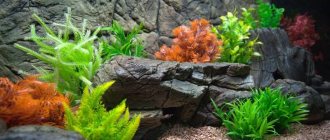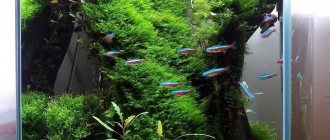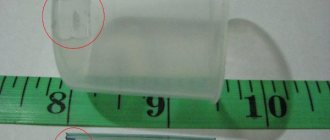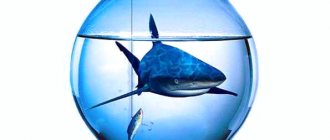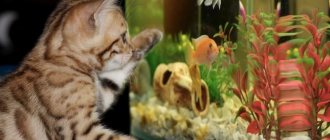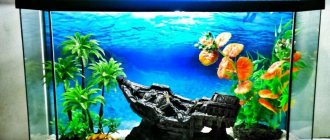Organizing an aquarium for plants
Herbal aquarium is a broad concept that can include:
- Standard artificial pond with living flora.
- A Dutch-style tank where vegetation is grouped by shape and color.
- Aquascape is a hand-crafted imitation of an underwater landscape.
What is common to all varieties of herbal aquarium is that the main role in the tank is played by representatives of flora, not fauna. In order for an aquarium with plants to turn out beautiful and function for a long time, before arranging the tank, you should find out what is needed for an herbalist.
Capacity
To create a herbalist, an aquarist will need a container, the height of which should not exceed 65 cm; you can choose an aquarium in the form of a glass. The small size of the vessel is due to the fact that when using higher containers it will be difficult for the owner to care for underwater flowers. If you plan to create a nano-herbalist, then you should select a container up to 30 cm high.
The best width for a tank with plants is up to 60 cm. There are various models of ponds in stores, but professionals advise purchasing containers with the smallest holes in the lids and a rectangular shape.
Suitable pH level
For a planted aquarium, the optimal pH is between 6.5 and 7.3. In this situation, the grass will receive the required amount of macro and microelements, due to which it will grow and develop. If the pH is below this norm, there is more carbon in the water. If it is higher, there is less carbon.
Lighting equipment
Light plays an important role in the growth and development of vegetation in the herbalist. Light bulbs that emit a red spectrum are selected as light for the aquarium. If the aquarium plants in the herbalist are represented by flowers, then you need to choose lamps with a blue spectrum, placing the devices in the center and in the foreground of the container. LEDs in the herbalist highlight individual places, focusing attention. LED lamps are complemented with fluorescent bulbs. When choosing the power and number of lighting devices, you should take into account the size, shape, and design of the aquarium, and the requirements of the plants.
Periodically, the lighting equipment is turned off to create a natural wilderness environment where day turns to night.
Filtration systems
Beginners should pay special attention to such a nuance as phytofiltration. A phytofilter is a device that creates the necessary water flow in an aquarium. Plants for the phytofilter can be any. It should be taken into account that the internal phytofilter takes up a lot of space in the tank, since the design includes a coarse filler. In this case, experienced owners recommend using a filter filter that includes synthetic fiber.
Phytofilter
Phytofiltration enriches water with oxygen, purifies water, and restores water balance. You can put a carbon phytofilter in the aquarium. These can be external or internal phytofilters.
Growing an underwater garden is a challenging but fun activity for novice aquascapers. If you pay attention to all the recommendations, follow them, follow the rules of the organization, you will end up with a beautiful, blooming underwater garden. Don't give up nano herbalist after the first unsuccessful attempt. Diligence will definitely bear fruit and after 3-4 attempts you will become an experienced aquascaper.
Water and carbon dioxide
To maintain comfortable conditions in the herbalist, the following devices are installed:
- Thermostat – for temperature control.
- Heaters - to create and maintain the required number of degrees of water. The optimal temperature is 24-26C.
For a do-it-yourself aquarium with an abundance of plants, the carbonate hardness is selected, which should be 4 units. Fertilizers are periodically added to the herbalist to maintain iron concentration. In addition, the attention of novice aquarists should be focused on the amount of nitrites and ammonia - an excess of these components leads to the death of the biobalance. The water in the herbalist is replaced every 8-10 days, updating 30-40% of the volume to avoid organic accumulations and dirt.
Carbon dioxide is an important condition for plant growth, so experienced aquarists ensure a regular supply of gas to the aquarium. The optimal accumulation of carbon dioxide is 15 mg/1 l of water.
Rules of care
Caring for the aquarium after planting the flora is as follows:
- Periodic addition of fertilizer.
- Change 20-50% of water every week.
- Control of carbon dioxide levels.
After planting the plants, it is not recommended to illuminate them too often. In the first week, the duration of daylight hours can be 5 hours, in the second week - 6 hours, in the third - 8 hours, etc.
Priming
The soil in which the plants will be planted can be of three types:
- Nutrient support.
- Soil with useful components.
- Neutral substrate.
Empty soil, which is basalt or quartz chips, does not include nutritional components, so when using this type, you should add fertilizer yourself. Experienced owners do not recommend placing a large-fraction substrate in the herbalist - you need to choose medium-sized particles.
Before adding soil to the aquarium, the substrate is washed to remove dirt and impurities. After laying out, the herbalist is filled with water, and the flora is planted after the soil has silted. No medications are administered.
Review of popular brands
Most world-famous brands have switched to the production of specialized nutrient soils for herbalists.
Many brands of aquarium substrates have been tested by users, so we can present a rating of the best compositions:
Prodibio AquaGrowth Soil and AquaShrimp Powder
Prodibio is a French brand that has earned a lot of positive reviews from aquascapers in Russia and other countries. The difference between the two brands of this manufacturer is the size of the fractions - from 1 to 3 mm - the first, from 0.6 to 1.2 mm - the second. The soils are densely charged with microelements. The composition has been carefully analyzed for harmful impurities.
Gloxy Soil
A mixture of domestic production from the company Aqua Logo. There are no customer reviews for this soil yet, but in terms of composition and price, the option is quite acceptable. The substrate is made from natural, pre-heat-treated raw materials. Quickly creates ideal conditions for the growth of aquatic plants. Contains special colloids that clarify and filter water. Stabilizes the acidity level of water. The granules are durable and retain their shape for a long time, which prevents rapid caking of the soil.
JBL Manado
It is not a nutrient soil, but is recommended for aquariums by plants due to the high porosity of the granules and the ability to store fertilizers, releasing them as needed. Particle sizes are 0.5-2 mm. The material is clay. The soil has one drawback: it is very light, which can cause plants with poorly strengthened root systems to float to the surface, especially when keeping burrowing fish in the aquarium.
Dennerle shrimp king active soil
Produced from carefully selected natural soils that provide plants with essential minerals and trace elements. The main component is irregularly shaped earth grains with a diameter of 1 to 4 mm. They give the aquarium a natural look. The soil does not promote the growth of algae and does not color the water. The porous surface is ideal for bacterial growth.
Dennerle scaper s soil
Nutrient substrate with a high content of micro- and macroelements. The basis of the mixture is volcanic andozol. The soil filters water, stabilizes its acidity, and removes hardness. Special components prevent algae from growing in the aquarium.
Dennerle DeponitMix
Nutrient mixture for herbalists, which is recommended to be used as a substrate. The basis is neutral quartz sand, the nutritional components are peat, soil and clay. To give plants a bright green color, chelated iron compounds are added to the mixture. Porous granules filter water well and are actively populated by bacteria.
ADA Power Sand Special
ADA is a leading manufacturer of aquarium soils. This brand is used as a substrate. It contains nutrient granules made of porous volcanic stone and special additives that ensure rapid colonization of the bottom by bacteria.
Any ready-made mixture for an aquarium is intended for use for up to 3 years. Then it must be changed.
Plants for the herbalist
The following plants are suitable for filling the herbalist:
- Foreground - lileopsis, arrowhead, tender echinodorus, lobelia, and tiny sintyaga.
- The background is water lilies, anubias, cryptocorynes and other species that can easily tolerate darkening.
Medium-sized varieties are planted between the background and foreground plants to create contrast.
Rules for planting vegetation:
- The maintenance requirements of flora varieties must be the same.
- Before planting, plants are inspected for rot and damage.
- First of all, fill the center of the aquarium, then move to the foreground and background.
- Planted flowers are carefully looked after: leaves and roots are trimmed, and fertilized.
Stages of starting a herbalist
The well-being of the green inhabitants of the herbal aquarium depends on the sequence in which the aquarist starts the tank. Failure to follow the rules on how to plant plants in an aquarium will lead to cloudy water, illness and death of pets, so beginners should follow the step-by-step instructions for starting an aquarium from scratch:
- The container is rinsed from dirt and wiped dry with a towel.
- A nutrient substrate is placed in the aquarium, then soil.
- Fill the container halfway with water, making sure that the stream of water does not wash away the soil.
- Decorations are installed inside the tank as desired.
- The remaining water is poured into the container and the equipment is connected.
- A day later, after checking the suitability of the aquatic environment, the fish are released.
Proper launch of the herbalist will ensure rapid growth and normal development of the flora. Despite the fact that growing underwater flora at home is a complex process, following the rules and recommendations of experienced aquarists, you can independently grow a real jungle underwater.
Tricks of the process
Compared to both traditional aquariums and home gardens, Aquafarm requires minimal installation and maintenance efforts.
As with any other aquarium, the water will need to sit for a couple of days. You don’t have to wait, but treat the water with the conditioner from the kit and start Aquafarm right away. Before releasing the fish, it should be allowed to get used to the chemical composition and temperature of the tank environment. To do this, just pour a little water into a temporary container with your pet.
